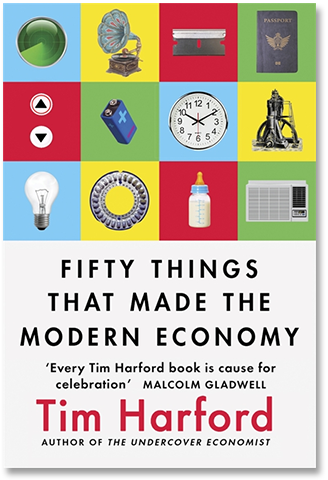Fifty Things That Made the Modern Economy, book review: Inventions with unexpected connections


Fifty Things That Made the Modern Economy • By Tim Harford • Little, Brown • 344 pages • ISBN: 978-1-4087-0911-5 • £18.99
In a November 2017 article in The Atlantic about the fortunes of Google X, the 'moonshot factory', Derek Thompson distinguishes between innovations and inventions. Innovations, the incremental improvements in existing technologies, are Silicon Valley's bread and butter. Inventions, or real breakthroughs, are harder to find and require the kind of commitment to basic research that's rare today in even the biggest corporate labs.
In Fifty Things That Made the Modern Economy, 'undercover economist' Tim Harford focuses on the hard stuff: inventions. Many of these are things that have been with us for so long -- and are so distant from many people's lives -- that we rarely remember their significance: the plough, barbed wire, cuneiform. If you'd rather listen than read, the book has a companion in the form of 51 downloadable BBC podcasts.
Everyone who reads this book probably has a different list of things they wish had been included. Personally, I would have liked to have seen a nod to the textile arts -- particularly knitting and weaving. In science and technology, however, there are plenty of entries: the compiler, Google Search, robots, video games, public key cryptography, intellectual property, the chemical process that makes fertilisers, radar, and batteries. Among financial technologies, (economist) Harford includes tally sticks, paper money, the Kenyan mobile money system M-Pesa, tax havens, and insurance.
Unintended consequences
The choices may seem random. In his introduction, and with a nod to Connections author James Burke, Harford explains that he wasn't trying to pick the fifty most significant inventions, but those with unexpected connections. At its heart, this is not a book about inventions: it's a book about unintended consequences. For example, antibiotics in farming helped animals fatten up faster, but raises the likelihood of drug resistance.
No-one can be an expert on everything. So Harford understood the significance of Grace Hopper's first compiler in introducing the first of what has become many layers of abstraction, making programming more widely accessible. But he stops before considering the broader consequences, such as the spread of insecure software, of opening programming to non-experts.
Similarly, although Harford connects market research to Google's famous 41 shades of blue, he does not go on to link it to today's most direct form -- the pervasive tracking that Shoshana Zuboff has dubbed 'surveillance capitalism'. Still, I particularly like the breakdown of the numerous technologies that had to be invented to create the iPhone, while his discussion of intellectual property, although as brief as those of the other 49 inventions, gets right to the point in discussing its expansion.
Overall, this is the sort of book that's fun to dip into for an unexpected insight or a bit of historical development. Probably everyone knows at least a few of the connections Harford explores, but few will know all of them.
PREVIOUS AND RELATED CONTENT
Which tech is most likely to transform the world?
A new report has machine learning at the top of the list.
Robotics in business: Everything humans need to know
An executive guide to the technology and market drivers behind the $135 billion robotics market.
Disruption as a service: Where the tech industry will pounce in 2018
The speed bumps of 2017 haven't slowed down the technology revolution. ZDNet's lead editors predict where the next innovations will change the course of business and tech.
Read more book reviews